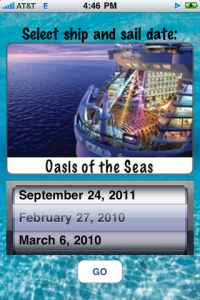How Green Are Cruises? – By The Numbers
categories: UncategorizedThere has been a flame war on twitter recently between travel bloggers about what the ecological impact is of “mega cruise ships” on global warming. There are three main issues that I have seen raised:
- Cruise ships consumer water
- Cruise ships burn fuel
- Cruise Ships dump sewage at sea
These are all true, but how true are they? A recent article on Cruise Law stated in an article about Royal Caribbean’s new Oasis of the Seas :
Follman’s intuition is that the experience would be akin to “feasting on a nine-course meal in the middle of an Ethiopian refugee camp.” He cites an article by Rory Nugent in the Atlantic magazine which questions the rationale of building such a monstrosity. According to the article “Hope Floats,” the passengers will consume 560,000 gallons of water a day, and the ship will burn 12 tons of diesel an hour. Although Royal Caribbean and the cruise industry’s 16,000 travel agents may hope that the Oasis of the Seas will be a success, Mr. Nugent raises the question that the ship “may leave the dock already a dinosaur – a floating emblem of a bankrupt era.”
Oasis of the Seas
The Oasis of the Seas is in fact a large boat. The numbers that I see is that at maximum capacity it would hold 6,296 passengers and 2,165 crew for a total of 6,296 = 8461 people. It is a floating town. I hope we can agree on that much at least. That a ship that size will have some impact seems obvious.
Cruise passengers consume water
The Cruise Law article states that the passengers on the ship will consume 560,000 gallons of water a day. Boy that seems like a lot. But is it? Now I imagine that the crew will occasionally be given water but lets just assume as the article did that 560,000 is just for the passengers. Let’s assume that was the biggest number available so it is for the ship when full, that would be about 89 gallons of water a day.
According to the data at data360 the average American consumes 575 liters or about 152 gallons a day. So this is less than they would consume at home. Granted Americans consume more fresh water than anyone else but this would be less than a resident of Mexico. Now this is a bit misleading as someone is probably still watering their lawn and they are probably putting off doing laundry for a week but this would also be the case if they stayed at a land based resort.
In general in the world there is no shortage of water but there is a shortage of potable fresh water. A cruise ship can consume water by creating fresh water from sea water through desalinization. That process does use fuel.
Cruise passengers consume fuel
A cruise ship does use fuel and 12 tons of diesel seems rather a lot. Engines move the ship, run the lights, run desalinization plants and also run any sewage treatment machinery if the ship is thus equipped. But of course if all the passengers stayed home they would still be getting in their cars, turning on the lights and flushing their toilets. So how much more power is this than they would consume at home?
According to an article on nationmaster.com the average American uses 8.35 tons of fuel per year so in a day 6,296 American passengers (ignoring crew again who also would be turning on the lights at home) would use 149 tons of fuel a day or about 6.2 tons an hour. That is less than the 12 tons an hour the Cruise Law article says the ship will use, but is that when the ship is cruising at top speed? A ship in the harbor will consume much less power and most cruise ships are not moving for, I would estimate, about 2/3 of a day. That will of course vary by the cruise. So I suspect these numbers are actually much closer if the 12 tons an hour is at peak power demand.
Cruise passengers poop
This seems to be the largest concern addressed in the brouhaha in the twitter stream recently. Now of course we know that they will poop almost as much if they stay home (probably somewhat less as they are probably overeating).
So the biggest concern here is what happens to the poop. Certainly on some of the older cruise ships this gets dumped at sea because may cruise ports don’t have (and many don’t want the expense of) dealing with the cruise ship sewage. The biggest concern here is that sewage dumped at sea can cause the growth of algae which produces greenhouse gases can harm other sea life. The U.S. outlawed cities dumping sewage at sea with the Ocean Dumping Ban Act passed in 1988 and implemented by 1991. Some nations still dump sewage at sea and in greater amounts than any cruise ship. Most recently Western Canada stirred a controversy with this practice and still dumps 6% of their sewage into the San Juan islands.
Ironically, the ship that has stirred this recent controversy is the Oasis of the Seas which does not dump sewage in the sea.
While environmentalists have said that the ship does not do enough to reduce air pollution and burns more fuel than a land-based resort, engineers at shipbuilder STX Finland said environmental considerations played an important part in planning the vessel. It dumps no sewage into the sea, reuses its waste water and consumes 25 percent less power than similar, but smaller, cruise liners.
via Environmental Impact of Cruise Ships
Some cruise ships are better than others. Some cruise lines are better than others. But if we are going to have the conversation, let’s do it with real numbers.
- Book Your Accommodation HERE
- Book discount cruises HERE
- Buy Travel Insurance
- Search for Great Tours HERE
- Get a Car Rental
+Chris Christensen | @chris2x | facebook
6 Responses to “How Green Are Cruises? – By The Numbers”
Leave a Reply
Tags: article, cruise travel


 Theme Based Cruises
Theme Based Cruises Ship Mate – an iPhone App for Royal Caribbean Cruise Passengers
Ship Mate – an iPhone App for Royal Caribbean Cruise Passengers Book Review – “Crash Course: Getting a Job on a Cruise Ship”
Book Review – “Crash Course: Getting a Job on a Cruise Ship”

Becky
Says:November 8th, 2009 at 11:31 pm
Great article, Chris… it is good to match apples with apples. Sure, my immediate reaction to reading the numbers at first is to “wow”ed at how much of everything is used, but matching it up to what we actually use on a daily basis puts it into perspective.
Gary
Says:November 9th, 2009 at 9:11 am
Algae consumes CO2. The danger with algae is that is chokes other sea life.
chris2x
Says:November 9th, 2009 at 9:32 am
sorry, my bad
Lorene Romero
Says:November 23rd, 2009 at 11:14 pm
Spot on, Chris. Great job on this article
Andy
Says:July 16th, 2013 at 3:42 pm
Hey Chris, great article, and as someone also putting together an article on the eco-friendliness of cruise ships, good job on taking on the task. A lot of statistics when you get to things the size of cruise ships and towns are not very straightforward, and much footwork must be done to make sure you’re comparing apples to apples.
I took a cruise ship across the Atlantic, and I’m working on comparing it to flying across the ocean. It’s going to be hard to compare, but I’m guessing that on a person-mile per gallon basis, it’ll come out ahead.
chris2x
Says:July 17th, 2013 at 8:23 am
Andy, I think you are correct about the person-mile basis.